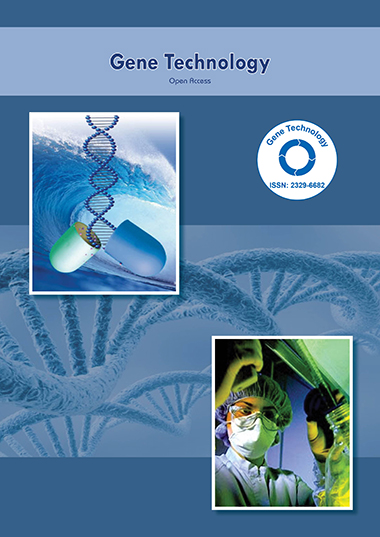PMC/PubMed Indexed Articles
Indexed In
- Academic Keys
- ResearchBible
- CiteFactor
- Access to Global Online Research in Agriculture (AGORA)
- RefSeek
- Hamdard University
- EBSCO A-Z
- OCLC- WorldCat
- Publons
- Euro Pub
- Google Scholar
Useful Links
Share This Page
Journal Flyer

Open Access Journals
- Agri and Aquaculture
- Biochemistry
- Bioinformatics & Systems Biology
- Business & Management
- Chemistry
- Clinical Sciences
- Engineering
- Food & Nutrition
- General Science
- Genetics & Molecular Biology
- Immunology & Microbiology
- Medical Sciences
- Neuroscience & Psychology
- Nursing & Health Care
- Pharmaceutical Sciences
Perspective - (2022) Volume 11, Issue 6
Type V CRISPR-Associated Transposon Complex in Structural Basis
Joseph Paul*Received: 23-Nov-2022, Manuscript No. RDT-22-19237; Editor assigned: 28-Nov-2022, Pre QC No. RDT-22-19237 (PQ); Reviewed: 13-Dec-2022, QC No. RDT-22-19237; Revised: 21-Dec-2022, Manuscript No. RDT-22-19237 (R); Published: 29-Dec-2022, DOI: 10.35248/2329-6682.22.11.209
Description
Prokaryotic Clustered Regularly Interspaced Short Palindromic Repeats (CRISPR)-Cas systems' primary purpose is to give adaptive protection against invasive mobile genetic elements like plasmids, transposons, and phages. This is dependent on Cas protein effector complexes, which facilitate the recognition of target nucleic acids by CRISPR RNA (crRNA) and the subsequent nucleolytic breakdown of those nucleic acids. To guide transposon DNA insertion into certain target sites, a number of Tn7-like transposons have coopted RNA-guided type I, subtype F (I-F), I-B, and V-K CRISPR-Cas systems. CRISPRAssociated Transposons (CASTs) have CRISPR-Cas modules that are either nuclease-deficient multisubunits or single subunits. A CRISPR spacer-repeat array, many genes encoding the transposon machinery, a cascade complex in type I systems, or a single catalytically inactive Cas12k pseudonuclease in type V-K systems are implanted between the left and right transposon end sequences. The transposase is then brought in to catalyse transposon DNA insertion at a predetermined distance downstream of the precise target DNA site by the DNA-targeting effectors, which attach to target sites designated by the crRNA guides. It has been postulated that CAST systems, which frequently carry additional defence systems as cargo, can facilitate horizontal gene transfer of host defence systems inside bacterial populations by acting as shuttle vectors for other transposons and plasmids. In contrast to crRNAs produced from CRISPR arrays, which target integration into host chromosomal locations for transposon homing in type V-K systems, delocalized crRNAs seek insertion of transposons into other mobile genetic elements.
Target site recognition in type V-K systems is carried out by an artificial Single-Molecule Guide RNA (sgRNA) fusion or a CRISPR effector complex made up of Cas12k programmed with a dual guide RNA structure made up of crRNA and a Trans- Activating RNA (tracrRNA). It was discovered through biochemical and structural analyses of a type V CAST system from Scytonema hofmanni (ShCAST) that the precise positioning of Cas12k and the crRNA guide for the identification of complementary targets depended on the complex architecture of the tracrRNA. The Target Strand (TS) DNA is the target of Cas12k's guide RNA hybridization, which results in the formation of an incomplete R-loop structure. This suggests that additional rearrangements brought on by the activation of the downstream transposon machinery are necessary to cause further hybridization between the guide RNA and the TS DNA.
It has been suggested that the DDE-type TnsB transposase catalyses the 3′-DNA strand breaking and transfer processes required for a replicative transposition mechanism, resulting in transposon end-nicking and ligation to a target DNA at sites positioned 60–66 Base Pairs (BP) downstream of the PAM. This hypothesis is based on homology to the prototypical Escherichia coli E.coli Tn7 transposon. At the target location, TnsC is thought to attract and activate TnsB. TnsB stimulates TnsC's ATPase activity in order to engage with the TnsC filament and cause its disintegration. Target immunity, a common trait of transposons possessing coupled transposase and AAA+ ATPase components, is ensured by preventing the insertion of new transposon copies into the same location. When linked to dsDNA in the ADP-bound state, TnsC forms a hexameric ring, which raises the possibility that this intermediate could serve as a link between the Cas12k-DNA targeting complex and TnsB upon ATP hydrolysis, offering a molecular ruler mechanism for defining insertion sites. An entire CRISPR-transposon assembly's structural specifics, however, are still unclear. TniQ's purpose is likewise currently unknown. TniQ has been linked to the regulation of the polymerization of the TnsC filament in type V-K systems where it interacts directly with one end of the filament. On the other hand, a TniQ homodimer, together with the Cascade, is a crucial part of the DNA targeting complex in type I-F3 systems.
As site-specific, homology-independent DNA insertion tools to design bacterial hosts and communities, CASTs are programmable, targeted DNA integration machines. However the poor knowledge of their underlying molecular mechanisms has so far prevented their implementation in eukaryotic cells. Ribosomal S15 protein aids in the formation of the Cas12ktransposon complex. The E.coli ribosomal protein S15 (EcS15), which was caught in the Cas12k-transposon recruitment complex, is wedged in between the tracrRNA connector duplex and the Cas12k REC2 domain and makes contact with the ribose-phosphate backbone of the crRNA in the PAM-distal region of the crRNA-TS-DNA heteroduplex. EcS15 adopts a four-helix bundle shape just like the small ribosomal subunit and interacts with the tracrRNA and heteroduplex in a way that is similar to how it interacts with 16S rRNA. The REC2 (Helical II) domain in the unrelated Cas12e (CasX) nuclease has a helical fold that is very similar to the combined fold of EcS15 and the Cas12k REC2 domain.
Citation: Paul J (2022) Type V CRISPR-Associated Transposon Complex in Structural Basis. Gene Technol. 11:209.
Copyright: © 2022 Paul J. This is an open access article distributed under the terms of the Creative Commons Attribution License, which permits unrestricted use, distribution, and reproduction in any medium, provided the original author and source are credited.

